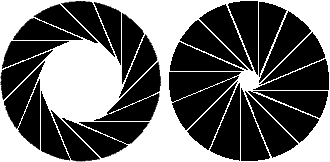Flashgun Guide Number.
![]()
What is The Flashgun Guide Number?The Flashgun Guide Number is a number given to a specific Flashgun at a specific ISO rating to help calculate the required "ƒ", (aperture) setting for a camera in certain conditions! To calculate the correct "ƒ" number for your camera to match the Flashgun three criteria need to be known. To calculate the "ƒ" number, divide the Guide Number by the Subject Distance. For example: You could of course use this simple aperture calculator link button... ISO Guide Number Formula:The formula or calculation for a Guide Number is derived from a known ISO value and Guide Number and is attained like so... Take the example given where the known ISO value is 100 and the Guide Number is 20, to get an answer of 20 from 100 the formula is... To find the Guide Number for ISO 200 the following applies... √ 200 x 2 = 28.284, the nearest whole number to this is 28, so the Guide Number for ISO 200 is 28. The reason we have to use a formula in this way is because we are dealing with aperture sizes and it is a common mistake to think that doubling the ƒ number halves the amount of light when in fact it is a factor of one quarter. Example: To double the aperture size from ƒ16 to ƒ11 the formula is √16² ÷ 2 = 11.314, the nearest whole number to this is 11 so double the aperture size is ƒ11. Light Path Distance:It should also noted that the distance used in the formula is the distance the light has to travel from the Flashgun to the subject, not the distance the camera is away from the subject. Using the same set up example, if the Flashgun head was tilted to 45 degrees the distance the light travels to the subject would increase to 3.54 Meters even though the camera is still only 2.5 Meters away. |
 Flashgun set 2.5 Meters from subject.  ISO Distance Guide Number Chart.  Examples of relative aperture sizes ƒ8 is half the area of ƒ5.6 but twice the area of ƒ11.  The aperture centre is made up from overlapping segments so it is not perfectly round.  This shows the difference in length when using "Bounce" Flash even though the subject is the same distance from the camera. |
All trademarks and copyrighted material are property of their respective owners